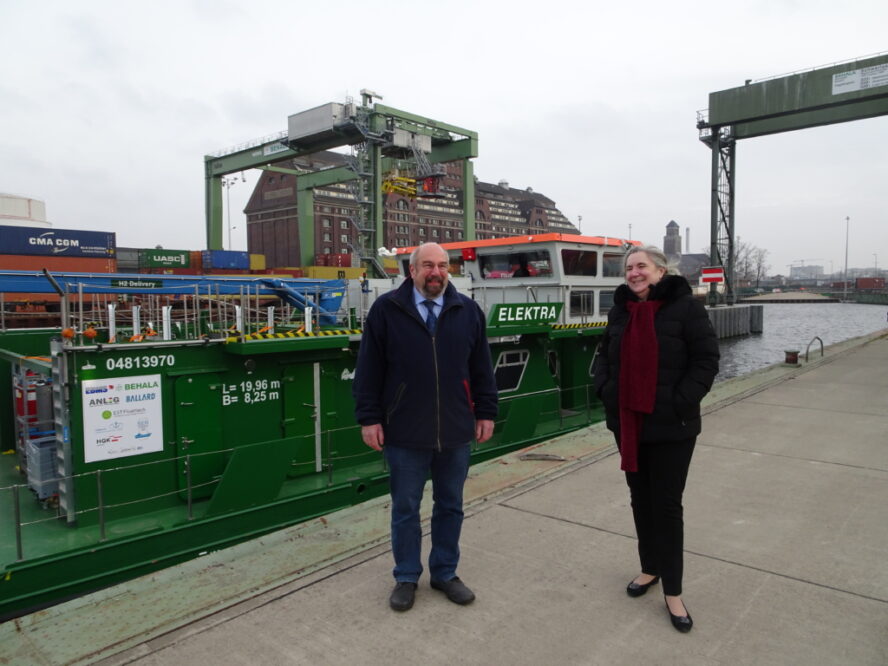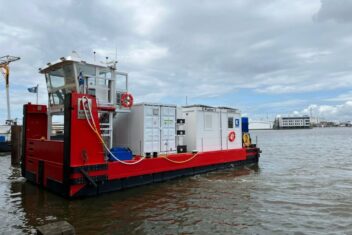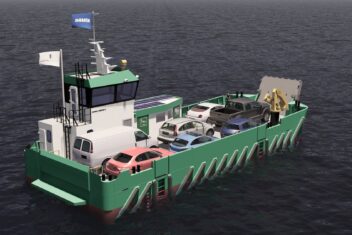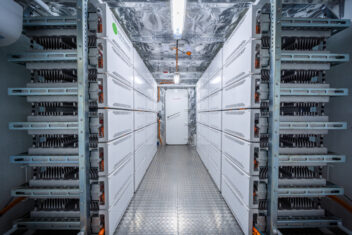“ELEKTRA” Arrival

The ELEKTRA arrived in Berlin’s Westhafen. After almost two years of construction at the shipyard Hermann Barthel GmbH in Derben and the three-day transfer to Berlin’s Westhafen, the testing of this unique, innovative and emission-free push boat can now begin.
Under the project management of the Department of Design and Operation of Maritime Systems at the TU Berlin, the following companies are involved in the project. BEHALA – Berliner Hafen- und Lagerhausgesellschaft (logistics), Shipyard Hermann Barthel, BALLARD Power Systems (fuel cells), ARGO – ANLEG (hydrogen system), Schiffselektronik Rostock (electric power system), EST-Floattech (battery system) and HGK Shipping (nautical operation) participated in the development and in the construction and testing of the ELEKTRA as partners.
First zero-emission vessel
The ELEKTRA will serve as a role model as the first zero-emission vessel, and this energy system is designed to be transferable to a wide range of inland and coastal vessel types. This is not just about providing energy for the ship’s propulsion. The push boat has its tasks in pushing thrusters, but at the same time the crew lives and works on board.
In addition to the main propulsion system, energy must also be provided for the temperature control of the rooms, the wheelhouse, the crew cooks and washes on board, and the batteries also have to be kept at “comfortable feel-good” temperatures for efficient operation and a long service life. All of this must function with a limited amount of energy carried and without loss of range.
The waste heat from the fuel cells is used by means of consistent water cooling, and the rooms are heated via a water-to-water heat pump is used to heat the rooms, the advantage here being that the ship always has water with temperatures above 0° C under the keel is available. The use of a self-developed energy management system and a driving assistant support the ship’s skipper and logistician in planning the operations and carrying out the transports.
With 750 kg of usable gaseous hydrogen at a pressure of 500 bar on board and a battery capacity of 2,500 kilowatt hours, the ship has a range of approx. 400 kilometers in a pushed convoy with the loaded URSUS heavy-lift lighter, the ship has a range of approx. 400 kilometers, i.e. in the trade lanes from Berlin Rhine/Ruhr, Hamburg and Szczecin, we only need one additional shore station to supply the ELEKTRA with hydrogen and electricity.
Both in Berlin’s Westhafen and in the port of Lüneburg, the first shore stations for the hydrogen tanks and the charging current in the required power class of 500 kilowatts will go into operation in 2023.
Multiple Energy Gas Container
With the Industrial and Commercial Park Mittelelbe / H2 Green Power & Logistics GmbH the Department of EBMS of the TU Berlin has signed a supply contract for the filling and transport of the tank systems (Multiple Energy Gas Container – MEGC) with green hydrogen until the end of the project duration at the end of 2024.
The MEGC can be exchanged with the on-board crane and the power connection is made via a loading gallows, to which the cables are routed on shore. For the ship’s crew, handling the arm-thick cables is thus very easy and the ship is connected to the charging station in a short time and the pier is free of cables.
Initially, the trials will mainly take place in the capital region, but from 2023 onward, they will then be extended to long-distance services in the direction of Hamburg.
We still have to pass the nautical inspection by the inspection commission and sail in different push boat configurations on the Havel in Berlin, and we look forward to the trial phases of the project. In the end, we will have learned a lot and we will then also be able to say how future marketable ships in this power class will have to be optimally equipped and how the concepts for other ship types and power classes may look like.
With a total project volume of approx. €13 million, the project is funded by the German Federal Ministry of Transport and Digital Infrastructure (BMVI) with approx. 8 million € and is coordinated by Project Management Jülich (PTJ) and the National Organization for Hydrogen and Fuel Cell Technology (NOW).


